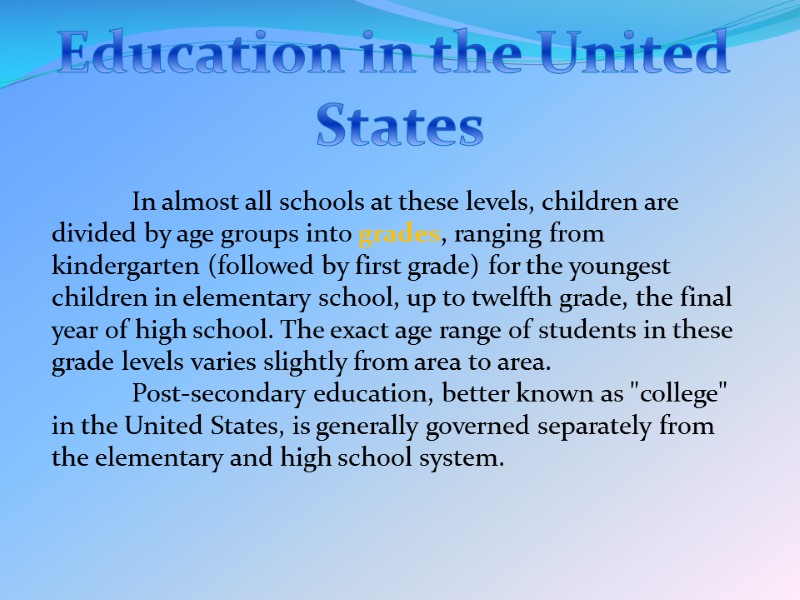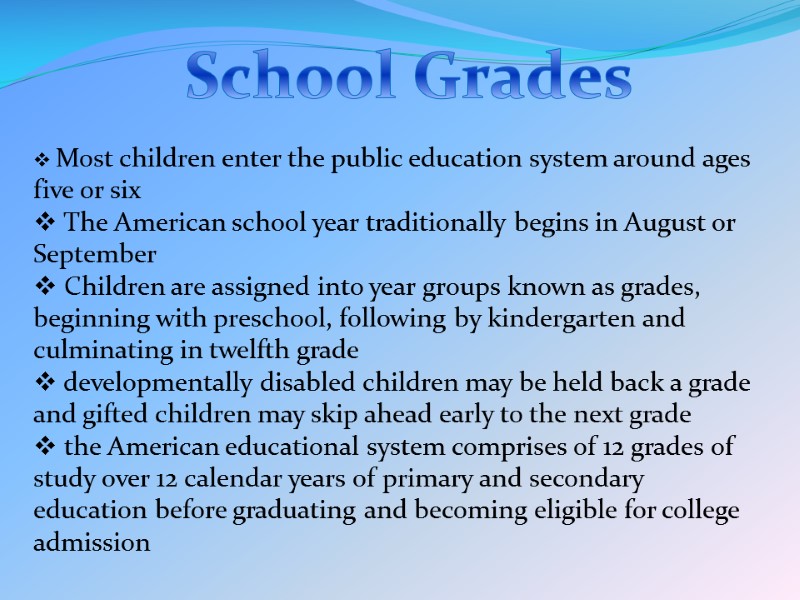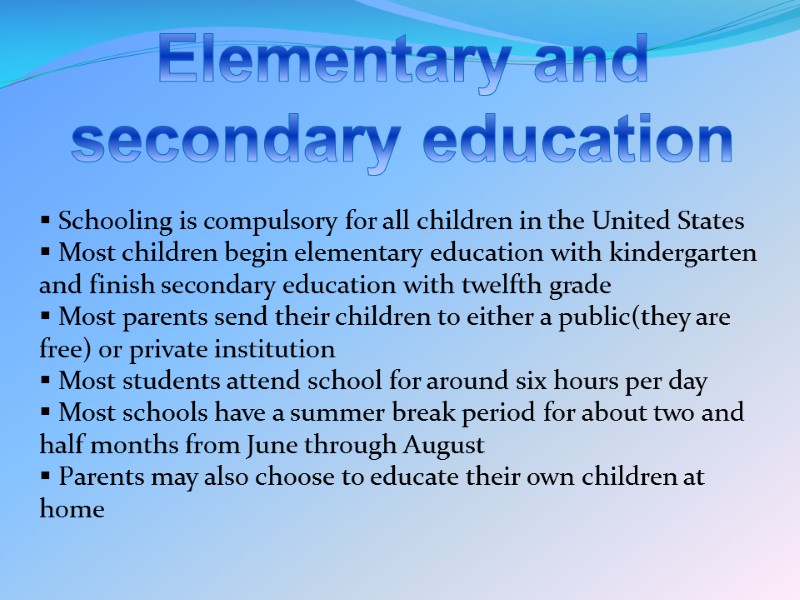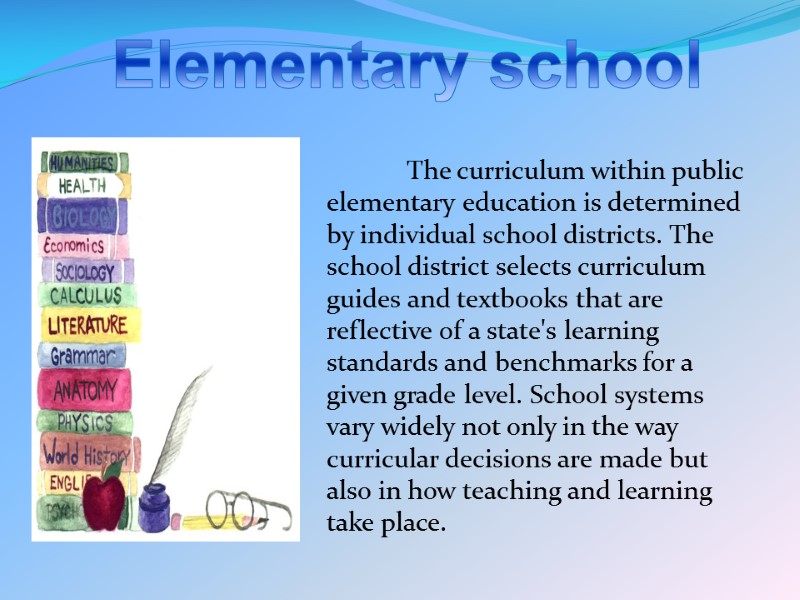Education in the USA Dayneko Ira Education in






























11408-education_in_the_usa.ppt
- Количество слайдов: 29
 Education in the USA Dayneko Ira
Education in the USA Dayneko Ira
 Education in the United States Education in the United States is mainly provided by the public sector, with control and funding coming from three levels: federal, state, and local. Child education is compulsory. Public education is universally available. School curricula, funding, teaching, and other policies are set through locally elected school boards with jurisdiction over school districts with many directives from state legislatures. School districts are usually separate from other local jurisdictions, with independent officials and budgets. Educational standards and standardized testing decisions are usually made by state governments.
Education in the United States Education in the United States is mainly provided by the public sector, with control and funding coming from three levels: federal, state, and local. Child education is compulsory. Public education is universally available. School curricula, funding, teaching, and other policies are set through locally elected school boards with jurisdiction over school districts with many directives from state legislatures. School districts are usually separate from other local jurisdictions, with independent officials and budgets. Educational standards and standardized testing decisions are usually made by state governments.
 Education in the United States The ages for compulsory education vary by state. It begins from ages five to eight and ends from ages fourteen to eighteen. A growing number of states are now requiring compulsory education until the age of 18.
Education in the United States The ages for compulsory education vary by state. It begins from ages five to eight and ends from ages fourteen to eighteen. A growing number of states are now requiring compulsory education until the age of 18.
 Education in the United States Compulsory education requirements can generally be satisfied by educating children in public schools, state-certified private schools, an approved home school program. In most public and private schools, education is divided into three levels: elementary school, middle school, and high school.
Education in the United States Compulsory education requirements can generally be satisfied by educating children in public schools, state-certified private schools, an approved home school program. In most public and private schools, education is divided into three levels: elementary school, middle school, and high school.
 Education in the United States In almost all schools at these levels, children are divided by age groups into grades, ranging from kindergarten (followed by first grade) for the youngest children in elementary school, up to twelfth grade, the final year of high school. The exact age range of students in these grade levels varies slightly from area to area. Post-secondary education, better known as "college" in the United States, is generally governed separately from the elementary and high school system.
Education in the United States In almost all schools at these levels, children are divided by age groups into grades, ranging from kindergarten (followed by first grade) for the youngest children in elementary school, up to twelfth grade, the final year of high school. The exact age range of students in these grade levels varies slightly from area to area. Post-secondary education, better known as "college" in the United States, is generally governed separately from the elementary and high school system.
 School Grades Most children enter the public education system around ages five or six The American school year traditionally begins in August or September Children are assigned into year groups known as grades, beginning with preschool, following by kindergarten and culminating in twelfth grade developmentally disabled children may be held back a grade and gifted children may skip ahead early to the next grade the American educational system comprises of 12 grades of study over 12 calendar years of primary and secondary education before graduating and becoming eligible for college admission
School Grades Most children enter the public education system around ages five or six The American school year traditionally begins in August or September Children are assigned into year groups known as grades, beginning with preschool, following by kindergarten and culminating in twelfth grade developmentally disabled children may be held back a grade and gifted children may skip ahead early to the next grade the American educational system comprises of 12 grades of study over 12 calendar years of primary and secondary education before graduating and becoming eligible for college admission



 Preschool Preschool education is the provision of education for children before the commencement of statutory education, usually between the ages of three and five, dependent on the jurisdiction. Preschool is also known as nursery school, or kindergarten.
Preschool Preschool education is the provision of education for children before the commencement of statutory education, usually between the ages of three and five, dependent on the jurisdiction. Preschool is also known as nursery school, or kindergarten.
 Preschool Preschool work is organized within a framework that professional educators create. The framework includes: structural component(administration, class size, teacher-child ratio, etc.) process (quality of classroom environments, teacher-child interactions, etc) alignment component(standards, curriculum, assessments). They are associated with each individual unique child that has both social and academic outcomes.
Preschool Preschool work is organized within a framework that professional educators create. The framework includes: structural component(administration, class size, teacher-child ratio, etc.) process (quality of classroom environments, teacher-child interactions, etc) alignment component(standards, curriculum, assessments). They are associated with each individual unique child that has both social and academic outcomes.

 Elementary and secondary education Schooling is compulsory for all children in the United States Most children begin elementary education with kindergarten and finish secondary education with twelfth grade Most parents send their children to either a public(they are free) or private institution Most students attend school for around six hours per day Most schools have a summer break period for about two and half months from June through August Parents may also choose to educate their own children at home
Elementary and secondary education Schooling is compulsory for all children in the United States Most children begin elementary education with kindergarten and finish secondary education with twelfth grade Most parents send their children to either a public(they are free) or private institution Most students attend school for around six hours per day Most schools have a summer break period for about two and half months from June through August Parents may also choose to educate their own children at home
 Elementary school Elementary school is a school of kindergarten through fifth grade where basic subjects are taught. Elementary school provides and often remain in one or two classrooms throughout the school day.
Elementary school Elementary school is a school of kindergarten through fifth grade where basic subjects are taught. Elementary school provides and often remain in one or two classrooms throughout the school day.
 Elementary school The curriculum within public elementary education is determined by individual school districts. The school district selects curriculum guides and textbooks that are reflective of a state's learning standards and benchmarks for a given grade level. School systems vary widely not only in the way curricular decisions are made but also in how teaching and learning take place.
Elementary school The curriculum within public elementary education is determined by individual school districts. The school district selects curriculum guides and textbooks that are reflective of a state's learning standards and benchmarks for a given grade level. School systems vary widely not only in the way curricular decisions are made but also in how teaching and learning take place.
 Secondary education Secondary education usually covers grades 6, 7, 8, 9, or 10 through 12. It consists of Middle and High school.
Secondary education Secondary education usually covers grades 6, 7, 8, 9, or 10 through 12. It consists of Middle and High school.
 Middle school Middle school and Junior high school are any school intermediate between elementary school and senior high school. It usually includes sixth, seventh and eighth grade; for "Junior high", ninth grade. Students are given more independence in choosing their own classes.
Middle school Middle school and Junior high school are any school intermediate between elementary school and senior high school. It usually includes sixth, seventh and eighth grade; for "Junior high", ninth grade. Students are given more independence in choosing their own classes.
 Senior high school Senior high school is a school attended after junior high school. High school usually runs either from grades 9-12 or from grades 10-12. The students in these grades are commonly referred to as freshmen (grade 9), sophomores (grade 10), juniors (grade 11) and seniors (grade 12).
Senior high school Senior high school is a school attended after junior high school. High school usually runs either from grades 9-12 or from grades 10-12. The students in these grades are commonly referred to as freshmen (grade 9), sophomores (grade 10), juniors (grade 11) and seniors (grade 12).
 Basic curricular structure At the high school level, students take a broad variety of classes. The following minimum courses of study are required in nearly all U.S. high schools: Science (usually two years minimum, normally biology, chemistry and physics) Mathematics (usually two years minimum, normally including algebra, geometry, algebra II) English (usually four years minimum, including literature, humanities, etc.) Social sciences (usually three years minimum, including various history, government/economics courses) Physical education (at least one year) Many states require a "health" course in which students learn about anatomy, nutrition, first aid, sexuality, and birth control. Anti-drug use programs are also usually part of health courses.
Basic curricular structure At the high school level, students take a broad variety of classes. The following minimum courses of study are required in nearly all U.S. high schools: Science (usually two years minimum, normally biology, chemistry and physics) Mathematics (usually two years minimum, normally including algebra, geometry, algebra II) English (usually four years minimum, including literature, humanities, etc.) Social sciences (usually three years minimum, including various history, government/economics courses) Physical education (at least one year) Many states require a "health" course in which students learn about anatomy, nutrition, first aid, sexuality, and birth control. Anti-drug use programs are also usually part of health courses.
 Electives Many high schools offer a wide variety of elective courses. Types of electives include: Visual arts (drawing, sculpture, painting, photography, film) Performing arts (drama, band, chorus, orchestra, dance) Technology education Computers (word processing, programming, graphic design) Athletics Publishing (journalism/student newspaper) Foreign languages (Spanish, French are common; Chinese, Latin, Greek, German, Italian)
Electives Many high schools offer a wide variety of elective courses. Types of electives include: Visual arts (drawing, sculpture, painting, photography, film) Performing arts (drama, band, chorus, orchestra, dance) Technology education Computers (word processing, programming, graphic design) Athletics Publishing (journalism/student newspaper) Foreign languages (Spanish, French are common; Chinese, Latin, Greek, German, Italian)
 Grading scale In schools in the United States children are continually assessed throughout the school year by their teachers, and report cards are issued to parents at varying intervals. Generally the scores for individual assignments and tests are recorded for each student in a grade book, along with the maximum number of points for each assignment. Grading scales usually differ from school to school, the most common grade scale is letter grades—"A" through "F"—derived from a scale of 0-100 or a percentile.
Grading scale In schools in the United States children are continually assessed throughout the school year by their teachers, and report cards are issued to parents at varying intervals. Generally the scores for individual assignments and tests are recorded for each student in a grade book, along with the maximum number of points for each assignment. Grading scales usually differ from school to school, the most common grade scale is letter grades—"A" through "F"—derived from a scale of 0-100 or a percentile.
 Standardized testing All American states must test students in public schools statewide to ensure that they are achieving the desired level of minimum education, such as on the Regents Examinations in New York, or the Florida Comprehensive Assessment Test (FCAT). During high school, students may take one or more standardized tests depending on their postsecondary education preferences and their local graduation requirements. The SAT and ACT are the most common standardized tests that students take when applying to college.
Standardized testing All American states must test students in public schools statewide to ensure that they are achieving the desired level of minimum education, such as on the Regents Examinations in New York, or the Florida Comprehensive Assessment Test (FCAT). During high school, students may take one or more standardized tests depending on their postsecondary education preferences and their local graduation requirements. The SAT and ACT are the most common standardized tests that students take when applying to college.
 Public and private schools public schools are free tax-funded class size varies from one district to another curriculum decisions are made at the local and state levels includes parochial schools , non-profit independent schools, and for-profit private schools private schools have various missions: most of them take sports very seriously and recruit athletes heavily, others are for gifted students, students with learning disabilities or other special needs, or students with specific religious affiliations private schools have no legal obligation to accept any interested student private schools offer the advantages of smaller classes Public schools Private schools
Public and private schools public schools are free tax-funded class size varies from one district to another curriculum decisions are made at the local and state levels includes parochial schools , non-profit independent schools, and for-profit private schools private schools have various missions: most of them take sports very seriously and recruit athletes heavily, others are for gifted students, students with learning disabilities or other special needs, or students with specific religious affiliations private schools have no legal obligation to accept any interested student private schools offer the advantages of smaller classes Public schools Private schools

 College and university Post-secondary education in the United States is known as college or university and commonly consists of four years of study at an institution of higher learning. The four undergraduate grades are commonly called freshman, sophomore, junior, and senior years. Students engage in undergraduate study, which consists of satisfying university and class requirements to achieve a bachelor's degree in a field of concentration known as a major. The most common method consists of four years of study leading to a Bachelor of Arts, a Bachelor of Science ,or sometimes another bachelor's degree such as Bachelor of Fine Arts, Bachelor of Social Work , Bachelor of Engineering or Bachelor of Philosophy.
College and university Post-secondary education in the United States is known as college or university and commonly consists of four years of study at an institution of higher learning. The four undergraduate grades are commonly called freshman, sophomore, junior, and senior years. Students engage in undergraduate study, which consists of satisfying university and class requirements to achieve a bachelor's degree in a field of concentration known as a major. The most common method consists of four years of study leading to a Bachelor of Arts, a Bachelor of Science ,or sometimes another bachelor's degree such as Bachelor of Fine Arts, Bachelor of Social Work , Bachelor of Engineering or Bachelor of Philosophy.

 College and university Graduate study, conducted after obtaining an initial degree and sometimes after several years of professional work, leads to a more advanced degree such as a master's degree, which could be a Master of Arts, Master of Science, Master of Business Administration , Master of Education or other less common master's degrees. Some students pursue a graduate degree that is in between a master's degree and a doctoral degree called a Specialist in Education . After additional years of study students may earn a Doctor of Philosophy or other doctoral degree, such as Doctor of Arts, Doctor of Education, Doctor of Medicine, Doctor of Physical Therapy.
College and university Graduate study, conducted after obtaining an initial degree and sometimes after several years of professional work, leads to a more advanced degree such as a master's degree, which could be a Master of Arts, Master of Science, Master of Business Administration , Master of Education or other less common master's degrees. Some students pursue a graduate degree that is in between a master's degree and a doctoral degree called a Specialist in Education . After additional years of study students may earn a Doctor of Philosophy or other doctoral degree, such as Doctor of Arts, Doctor of Education, Doctor of Medicine, Doctor of Physical Therapy.

 Thank you for your attention!
Thank you for your attention!

